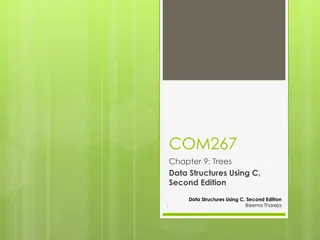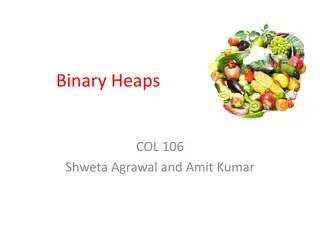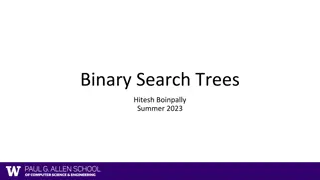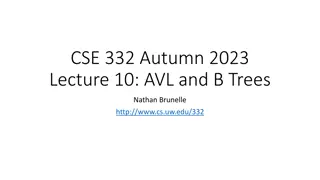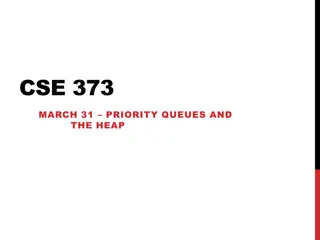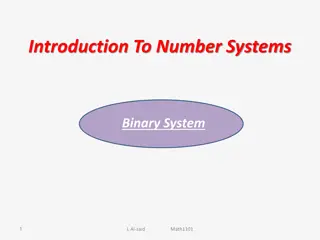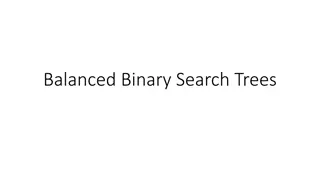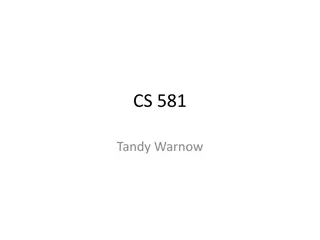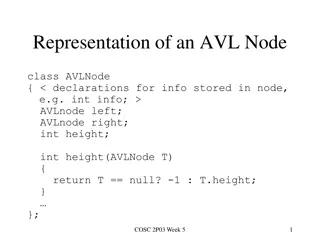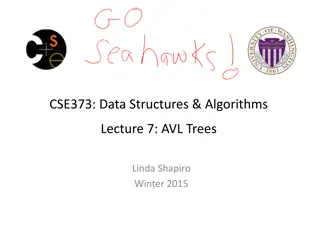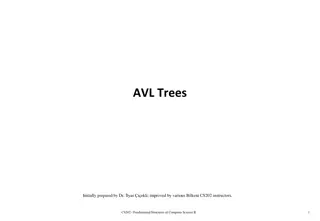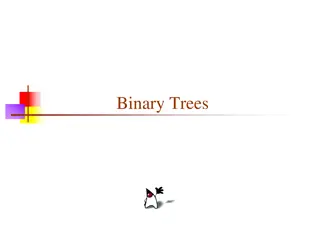Binary Search Trees and Balance Strategies
The concepts of Binary Search Trees (BSTs), including strategies for maintaining balance such as Red-Black trees. Learn about the importance of balance in BST operations and how different structures impact efficiency. Dive into the world of tree algorithms and height optimization for better data organization and retrieval.
Download Presentation

Please find below an Image/Link to download the presentation.
The content on the website is provided AS IS for your information and personal use only. It may not be sold, licensed, or shared on other websites without obtaining consent from the author. Download presentation by click this link. If you encounter any issues during the download, it is possible that the publisher has removed the file from their server.
E N D
Presentation Transcript
Creative Commons License CS2 in C++ Peer Instruction Materials by Cynthia Bailey Lee is licensed under a Creative Commons Attribution-NonCommercial- ShareAlike 4.0 International License. Permissions beyond the scope of this license may be available at http://peerinstruction4cs.org. CS106X Programming Abstractions in C++ Cynthia Bailey Lee
2 Today s Topics: Map Interface, continued 1. Binary Search Tree math (continued from Friday) How to maintain balance 2. Introduction to Hashing 3. C++ template details (if we have time)
Bad BSTs One way to create a bad BST is to insert the elements in order: 34, 22, 18, 9, 3 That s not the only way How many distinctly structured BSTs are there that exhibit the worst case height (height equals number of nodes) for a tree with 5 nodes? A. 2-3 B. 4-5 C. 6-7 D. 8-9 E. More than 9
BALANCE!!! The #1 issue to remember with BSTs is that they are great when balanced (O(log n) operations), and horrible when unbalanced (O(n) operations) Balance depends on order of insert of elements Not the implementor s control Over the years, implementors have devised ways of making sure BSTs stay balanced no matter what order the elements are inserted
Red-Black trees One of the most famous (and most tricky) strategies for keeping a BST balanced
Red-Black trees In addition to the requirements of binary search trees, red black trees must meet these: A node is either red or black. The root is black. All leaves (null children) are black. Both children of every red node are black. Every simple path from a given node to any of its descendant leaves contains the same number of black nodes.
Red-Black trees In addition to the requirements of binary search trees, red black trees must meet these: A node is either red or black. The root is black. All leaves (null children) are black. Both children of every red node are black. Every simple path from a given node to any of its descendant leaves contains the same number of black nodes. According to these, what is the greatest possible difference between the longest and shortest root-to-leaf paths in the tree? A. All root-to-leaf paths are equal length B. 25% longer C. 50% longer D. 100% longer E. Other/none/more than one
Red-Black trees Every simple path from a given node to any of its descendant leaves contains the same number of black nodes. This is what guarantees close to balance This file is licensed under the Creative Commons Attribution-Share Alike 3.0 Unported license. http://commons.wikimedia.org/wiki/File:Red-black_tree_example.svg
Insert procedure must maintain the invariants (this gets tricky) Video: http://www.youtube.com/watch?v=vDHFF4wjWYU This file is licensed under the Creative Commons Attribution-Share Alike 3.0 Unported license. http://commons.wikimedia.org/wiki/File:Red-black_tree_example.svg
Other BST balance strategies Red-Black tree AVL tree Treap (BST + heap in one tree! What could be cooler than that, amirite? ) Other fun types of BST: Splay tree Rather than only worrying about balance, Splay Tree dynamically readjusts based on how often users search for an item. Commonly-searched items move to the top, saving time B-Tree Like BST, but a node can have many children, not just 2
Hashing Implementing the Map interface with Hashing/Hash Tables
Imagine you want to look up your neighbors names, based on their house number (all on your same street) House numbers: 10565 through 90600 (roughly 1000 houses there are varying gaps in house numbers between houses) Names: one last name per house
Options Index value 0 1 10565 10566 10567 90598 90599 90600 KyungLee IsaiahWhite Solange Clark BST (balanced): Add/remove: O(logn) Find: Linked list: Add/remove: O(n) Find: Array: Add/remove: Find: O(logn) O(n)
Hash Table is just a modified, more flexible array Keys don t have to be integers 0-(size-1) (Ideally) avoids big gaps like our gap from 0 to 10565 in the house numbers and between numbers Hash function is what makes this possible!
Closed Addressing Array index 0 1 2 3 4 5 6 7 8 Value Where does key= Annie value=10 go if hash ( Annie ) = 3? Where does key= Solange value=12 go if hash( Solange ) = 5?
Hash collisions We may need to worry about hash collisions Hash collision: Two keys a, b, a b, have the same hash code index (i.e. hash(a) = hash(b))
Closed Addressing Array index 0 1 2 3 4 5 6 7 8 Value Where does key= Annie value=55 go if hashkey( Annie ) = 3? A. 55 overwrites 10 at 3 B. A link list node is added at 3 C. Other/none/ more than one
Hash key collisions We can NOT overwrite the value the way we would if it really were the same key Need a way of storing multiple values in a given place in the hash table
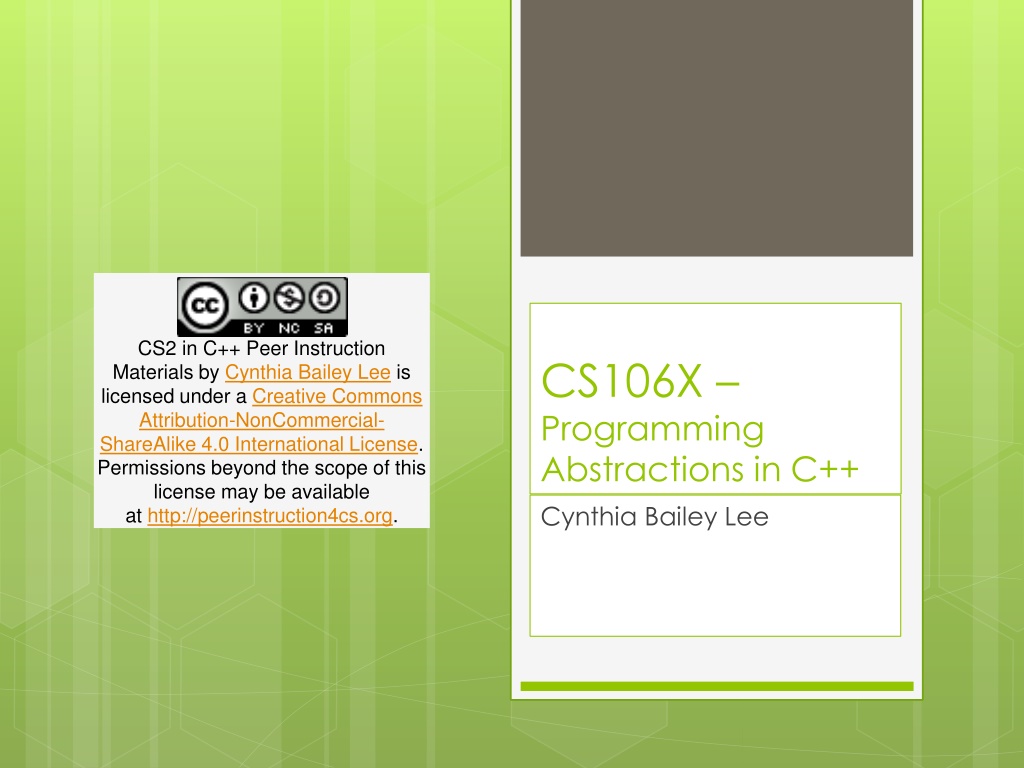
 undefined
undefined










